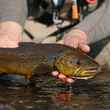A new study from biologists in the Czech Republic suggests trout can become addicted to illicit drugs that find their way into waterways, a stark reminder that human activity has a cascading effect on the environment as a whole.
The study, published in the Journal of Experimental Biology by Pavel Horký of the Czech University of Life Sciences Prague, used methamphetamine-tainted water to show that brown trout, which are native to the Czech Republic and prolific the world over, become habituated to the drug when it’s found the waters they inhabit and actively seek it out if they begin to experience withdrawals.
Horký and his team of researchers placed brown trout in water contaminated by low levels of meth — similar to water found from waste treatment plants that contained the same levels of the drug (1 microgram of meth per liter) — for eight weeks. Within four days of being moved to fresh water, the trout, if given the option, moved to water containing methamphetamine. The fish were offered the opportunity to swim into a current containing meth every other day for 10 days. Horký and his team concluded that the fish that spent two months in the meth-tainted water had a preference for that water when given the option between it and clean, non-contaminated water.
Is it enough evidence to clearly prove that trout can become addicted to human-produced drugs? Maybe not conclusively. But it does, indeed, show that water laced with the drug can induce a preference for the contaminated habitat. Also, according to the study, the fish exposed to meth were less active than fish living in the clean-water environment. What’s more, Horký and his team found traces of the drug in the fishes’ brains up to 10 days after the drug was removed from their water.
This isn’t the first instance of drugs or pharmaceuticals impacting fish. A 2013 study found that fathead minnows exposed to fluoxetine (Prozac) at levels found in some wastewater outflows in the U.S. and Canada showed signs of unnatural aggression. Females laid fewer eggs and males became less interested in reproduction. When exposed to higher levels male minnows actually become somewhat homicidal, killing females.
Another study, conducted in Texas in 2003, showed fish absorb the chemical that doctors prescribe to people from treated wastewater. The drug might help people, but it doesn’t appear to help fish. Instead, fluoxetine apparently has an adverse effect on fish behavior. Aggression and even changes in morphology have been documented in a number of studies conducted over the last 20 years.
The sources of the pharmaceutical pollution are predictable — the U.S. Geologic Survey, in a study conducted between 2004 and 2009, found that wastewater downstream from two pharmaceutical manufacturing plants contained levels of various commonly prescribed drugs between 10 and 1,000 times higher than wastewater from facilities that don’t treat effluent from pharmaceutical manufacturers.
It may not seem like a significant issue in the overall pollution spectrum, but Horký’s team raised an important concern based on his study’s findings — fish looking for a “fix” might gather in areas they might otherwise avoid, like wastewater outflows where the chemical they seek is found in higher concentrations.
“The elicitation of drug addiction in wild fish could represent another example of unexpected pressure on species living in urban environments,” he suggested in the study. In other words, chemicals found in water could encourage fish to change habitats in order to achieve the effects the tainted water has on their brains.
And, according to Horký’s study, even low levels of the drug have a noticeable impact on fish behavior. Many wastewater outflows contain much more than the one microgram-per-liter of meth used in the study.
Most wastewater treatment facilities aren’t equipped to filter out pharmaceutical contaminants in water — it may become a standard requirement as new plants come online to replace older and less effective facilities, but there’s no guarantee that will be the case.
There are more than 4,000 medications prescribed by doctors to patients, and all of them, as they are discharged from the human body, end up in our wastewater. That’s not counting the illegal drugs, like the meth used in Horký’s study. The impacts these chemicals have on the environment — not just the fish that swim in tainted water — can be significant, but biologists are only beginning to uncover the severity of the pollution.
Dr. Paul Bradley, a research ecologist with the USGS, noted in a USGS podcast in 2008 that the scientific community is only starting to get its head around the issue of pharmaceutical pollution.
“And this is kind of the point. This is kind of an emerging environmental concern and these wastewater treatment plants were not originally intended to address this type of contamination and in fact are not actually intended to address contaminant concentrations at these part per trillion levels, these very very low concentrations,” Bradley said. “It turns out that there is evidence that even at these really low concentrations some of these emerging contaminants are actually harmful to the environment.”
Emerging contaminants. That’s the key description. For years, wastewater has been treated to remove solids and visible contaminants. These emerging contaminants — the chemicals we can’t actually see — are proving harmful to aquatic environments. Bradley notes that some drugs prescribed to people for therapeutic reasons impact fish in completely different ways. For instance, in two rivers in South Carolina, both male largemouth and smallmouth bass are exhibiting female characteristics, likely from endocrine disrupting compounds found in drugs prescribed by doctors to humans.
The solution? It’s complicated. A good start for people might be to stop disposing of expired or unneeded medication by flushing them down the toilet. Many communities offer drug take-back facilities for unwanted medications. But, as Bradley noted in the podcast, the eventual solution is going to be much more complex, and likely to involve further study that shows just how much of various pharmaceutical compounds is “safe” for rivers and streams and their inhabitants.
“And then the final thing we will probably need to do is we will need to adjust our treatment processes in the facilities so that we can actually lower the concentration and bring those releases into balance with the naturally occurring processes,” he said.































Comments
John replied on Permalink
WTF- As I was blissfully unaware, yet another hit for our land and water and all that occupy it's habitat. Hard to swallow as when something was broke, I'd fix it- period.
Pages